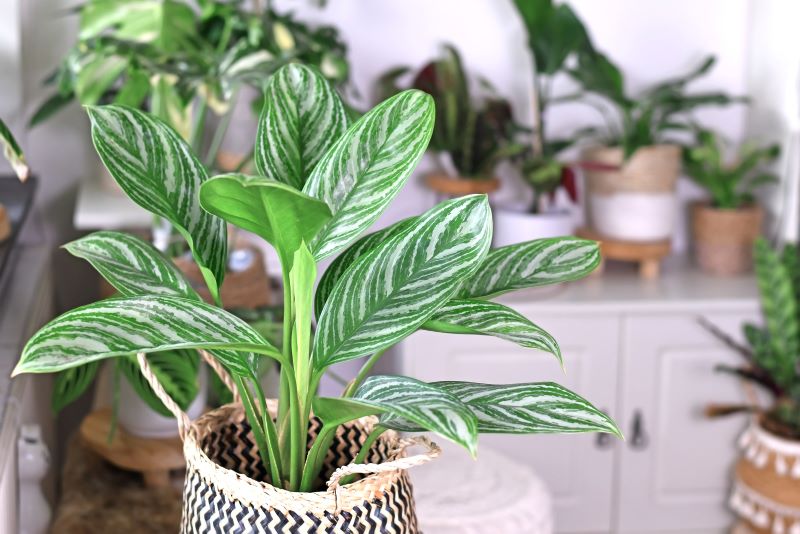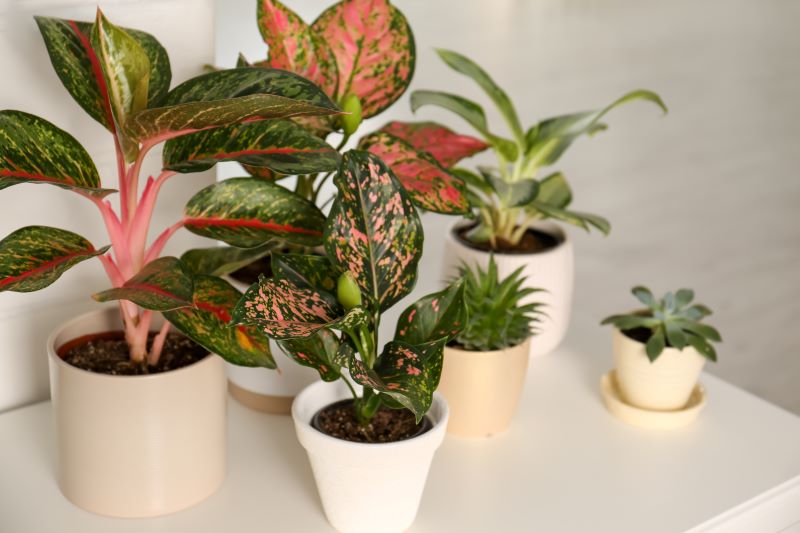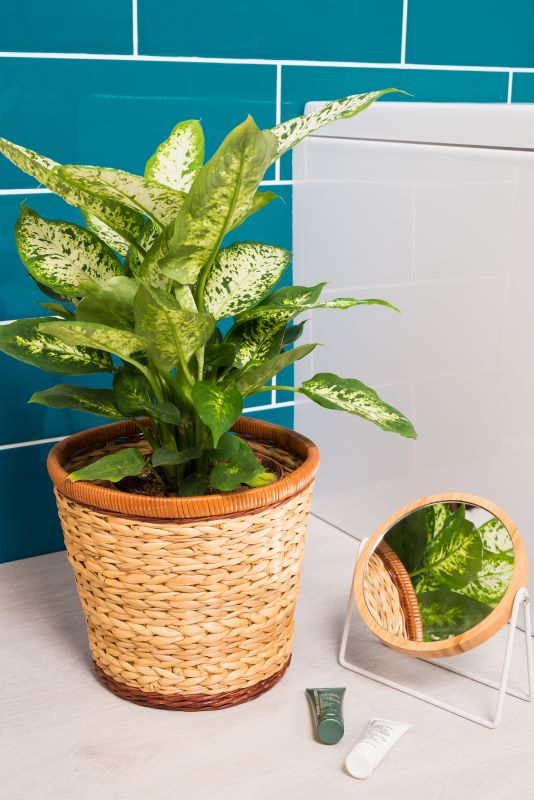If you are new to indoor gardening, Chinese Evergreen (Aglaonema) is a great plant to begin your collection. It is a sturdy plant that can survive in a range of temperatures and lighting conditions. Aglaonema care is easy enough that almost anyone can grow and maintain the plant indoors. Though it doesn’t produce many flowers, the leaves can be quite decorative. For this reason, Chinese Evergreen houseplants are a go-to for many indoor gardeners.
Chinese Evergreen houseplant leaves are long and oval in shape with a green color. There are a few different varieties of Chinese Evergreen plants that can have various color patterns. Some are simply green, and others have a combination of dark green, light green, silver or red. No matter the variety, the leaves can grow up to 12” long and 3” wide. As the plant ages, the stem can thicken to become more trunk-like. When it’s completely mature, the plant can grow to almost 36” in height.

Mature Chinese Evergreen houseplants can also produce small flowers during the summer that grow between the leaves. The flowers then turn into small berries, but neither the flower nor the berries are especially attractive. If you have pets or small children at home, you may need to remove the flowers before they turn to berries because the berries can be toxic if eaten.
Chinese Evergreen houseplants are generally very easy to grow. If you are a novice to indoor gardening, this is a good starter plant. Chinese Evergreen care is quite simple. It is a very durable plant that adapts well to its conditions.
Add some year round color to your home with a stunning Aglaonema
Aglaonema Care Instructions
Light
Chinese Evergreen (Aglaonema) do best in medium or low lighting with indirect sunlight. If the plant is in direct sunlight for too long, it can dry out and start dying. You may notice that the leaves start to turn brown or start to wither. If this is the case, move the plant to an area with less sunlight and prune the dead leaves off the plant.
When trying to find the right amount of lighting to help your Chinese Evergreen plant grow, err on the side of lower light. Because this is a low-growing tropical plant, it would naturally survive well in the shade of taller plants and may get ‘sunburnt’ if the light is too direct.

Water
Chinese Evergreen (Aglaonema) care is easy due to how little water it needs. When the soil starts to dry out a little bit, water it. If you don’t wait for the soil to dry out between waterings, the roots can get waterlogged and start to rot. Over-watering is a common reason for Chinese Evergreen houseplants to die when kept indoors.
Temperature and Humidity
This plant originates from the tropics and subtropics of Asia, so it does best in a warm environment with somewhat humid conditions. Ideally, keep it in an area of the house that stays above 65℉ even in the winter. Though Chinese Evergreen houseplants can tolerate lower temperatures if necessary, keeping it below the optimal temperature for too long can stunt its growth and cause the leaves to turn brown.

Perhaps the most difficult part about Chinese Evergreen care is keeping it in the right humidity. Plan to keep the plant in a room with medium to high humidity, the bathroom may be ideal! Because it originates from a tropical environment, it is not well-suited for dry air. If the air is too dry, the leaves can start to turn brown or shrivel.
Fertilizer
Part of proper Aglaonema care (especially for older plants) includes fertilizing it twice per year. Use a water-based plant fertilizer and dilute it to about half strength. Then fertilize the plant at the beginning of spring and at the end of summer. This will help your aging plant stay healthy throughout the year.
Pruning
Aglaonema care is easy because this plant typically does not require much pruning. If the leaves are starting to get too big or if they are starting to branch out too much, you can trim them to get the plant back to your desired size. Similarly, if the leaves are turning brown or withering, prune them while you adjust your plant care methods. However, you should not need to trim the plant to keep it alive.
Planting guide for a Chinese Evergreen (Aglaonema)
Soil
To get the best results from the Chinese Evergreen houseplant, make sure it is potted in well-draining soil. If the roots get waterlogged, they can rot and die. Try to get peat-based potting soil that is mixed with sand and perlite.
Propagating
One of the best ways to encourage Chinese Evergreen propagation is to use a cutting from the original plant and place it in some water. Cuttings start producing roots easily when placed in water. Then you can pot the new plant in well-draining soil. If you are worried that your original plant may be too far gone to survive, you can take a cutting to start growing a new plant and try again.

Common Chinese Evergreen (Aglaonema) Problems
Pests
There are a few bugs that can cause a Chinese Evergreen houseplant to become unhealthy. Spider mites, aphids, mealybugs, and scale can all cause problems for this plant. Before buying a plant to bring home, check the leaves, especially the undersides, to ensure that they don’t already have pests on them. Likewise, before taking a cutting from the main plant for propagation, ensure that you aren’t taking a cutting that already has pests on it.
Once you bring the plant home, check the leaves whenever you water it to make sure that pests aren’t starting to take hold. It’s much easier to remove the pests quickly than to wait until they have seriously damaged the plant.
Toxicity
The leaves and berries of Chinese Evergreen (Aglaonema) houseplants can be toxic when ingested.
Do’s & Don’ts
Do
- Keep the plant in 65℉ – 80℉
- Keep the plant in a humid environment
- Water the plant when the soil is dry
Don’ts
- Keep the plant in an area below 60℉
- Keep the plant in direct sunlight
- Over-water the plant
Our Summary of Aglaonema care
Chinese Evergreen (Aglaonema) care is very easy even when keeping the plant indoors. It is great for new gardeners and anyone who does not have much time to devote to their plant. It only needs to be watered when the soil becomes dry, and it requires low to medium lighting. If it gets enough humidity and is not over-watered or left in direct sunlight, the plant should thrive well in almost any home.




